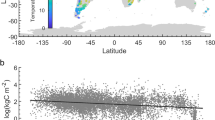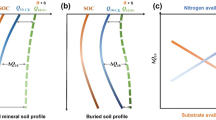Abstract
Histosols, often formed in wetland environments, provide an important global soil carbon (C) stock. Mineralization of soil organic C is an important process with broad implications for nutrient availability, soil quality, and global change. Temperature and moisture effects on C mineralization have been widely studied, but little information is available for temperature and moisture effects on C mineralization from recalcitrant sapric soil materials of warm climate Histosols. Our objectives were to determine Q 10 values (the factor by which the reaction rate increases with each 10 °C rise in temperature) for sapric soil material collected from a warm climate Histosol, to examine the influence of water content on Q 10, and to assess the optimum soil moisture condition for C mineralization. A laboratory incubation (48 h duration) was conducted including sapric soil material at three moisture conditions; approximately 0.15, 0.30, and 0.45 m3 m−3 water content by volume; and two temperatures; 25 and 37 °C. Calculated values for Q 10 were generally consistent with previous studies for other soil materials. Results indicated highest mineralization rates for both temperatures occurred at 0.30 m3 m−3 volumetric water content, corresponding to approximately 50 % water-filled pore space. But values for Q 10 increased as water content increased, demonstrating the important relationship between moisture and temperature effects for C mineralization for these organic soil materials.


Similar content being viewed by others
References
Anderson JPE (1982) Soil respiration. In: Page AL, Miller RH, Keeney DR (eds) Methods of soil analysis. Part two, second ed. Agron. Monogr. 9. ASA and SSSA, Madison
Anderson JM (1991) The effects of climate change on decomposition processes in grassland and coniferous forests. Ecological Applications 1:326–347
Bauhus J, Paré D, Côté L (1998) Effects of tree species, stand age and soil type on soil microbial biomass and its activity in a southern boreal forest. Soil Biology and Biochemistry 30:1077–1089
Boone RD, Nadelhoffer K, Canary JD, Kaye JP (1998) Roots exert a strong influence on the temperature sensitivity of soil respiration. Nature 396:570–572
Bowden RD, Newkirk KM, Rullo GM (1998) Carbon dioxide and methane fluxes by a forest soil under laboratory-controlled moisture and temperature conditions. Soil Biology and Biochemistry 30:1591–1597
Bridgham SD, Ping C, Richardson JL, Updegraff K (2001) Soils of northern peatlands: Histosols and gelisols. In: Richardson JL, Vepraskas MJ (eds) Wetland soils: Genesis, hydrology, landscapes, and classification. Lewis Publ, Boca Raton, pp 343–370
Carle MV (2011) Estimating wetland losses and gains in coastal North Carolina: 1994–2001. Wetlands 31:1275–1285
Collins ME, Kuehl RJ (2001) Organic matter accumulation and organic soils. In: Richardson JL, Vepraskas MJ (eds) Wetland soils: Genesis, hydrology, landscapes, and classification. Lewis Publ, Boca Raton, pp 137–162
Conant RT, Steinweg JM, Haddix ML, Paul EA, Plante AF, Six J (2008) Experimental warming shows that decomposition temperature sensitivity increases with soil organic matter recalcitrance. Ecology 89:2384–2391
Conant RT, Ryan MG, Agrens GI, Birge HE, Davidson EA, Eliasson PE, Evans SE, Frey SD, Giardina CP, Hopkins FM, Hyvonen R, Kirschbaum MUF, Lavallee JM, Leifield J, Parton WJ, Steinweg JM, Wallenstein MD, Martin Wetterstedt JA, Bradford MA (2011) Temperature and soil organic matter decomposition rates – synthesis of current knowledge and a way forward. Global Change Biology 17:3392–3404
Curiel Yuste J, Baldocchi DD, Gershenson A, Goldstein A, Mission L, Wong S (2007) Microbial soil respiration and its dependency on carbon inputs, soil temperature and moisture. Global Change Biology 13:2018–2035
Dahl TE (1990) Wetland losses in the United States: 1780’s to 1980’s. U.S. Department of the Interior, Fish and Wildlife Service, Washington. DC
Eswaran H, Van Den Berg E, Reich P (1993) Organic carbon in soils of the world. Soil Science Society of America Journal 57:192–194
Everett KR (1983) Histosols. In: Wilding LP, Smeck NE, Hall GF (eds) Pedogensis and soil taxonomy II. The soil orders. Elsevier Scientific Publishers, Amsterdam, pp 1–53
Ewing JM, Vepraskas MJ (2006) Estimating primary and secondary subsidence in an organic soil 15, 20, and 30 years after drainage. Wetlands 26:119–130
Fang C, Moncrieff JB (2001) The dependence of soil CO2 efflux on temperature. Soil Biology and Biochemistry 33:155–165
Fang C, Smith P, Moncrieff JB, Smith JU (2005) Similar response of labile and resistant soil organic matter pools to changes in temperature. Nature 433:57–59
Fierer N, Craine JM, McLauchlan K, Schimel JP (2005) Litter quality and the temperature sensitivity of decomposition. Ecology 86:320–326
Ilstedt U, Nordgren A, Malmer A (2000) Optimum soil water for soil respiration before and after amendment with glucose in humid tropical acrisols and a boreal mor layer. Soil Biology and Biochemistry 32:1591–1599
Kirkman LK, Lide RF, Wein G, Sharitz RR (1996) Vegetation changes and land-use legacies of depressional wetlands of the western coastal plain of South Carolina. Wetlands 16:564–576
Kirschbaum MUF (1995) The temperature dependence of soil organic matter decomposition and the effect of global warming on soil organic C storage. Soil Biology and Biochemistry 27:753–760
Linn DM, Doran JW (1984) Effect of water-filled pore space on carbon dioxide and nitrous oxide production in tilled and nontilled soils. Soil Science Society of America Journal 48:1267–1272
Lomander A, Kätterer T, Andrèn O (1998) Carbon dioxide evolution from top- and subsoil as affected by moisture and constant and fluctuating temperature. Soil Biology and Biochemistry 30:2017–2022
Luo Y, Zhou X (2006) Soil respiration and the environment. Academic, New York
Nadelhoffer KJ, Giblin AE, Shaver GR, Laundre JA (1991) Effects of temperature and substrate quality on element mineralization in six arctic soils. Ecology 72:242–253
Prouty WF (1952) Carolina bays and their origin. Geological Society of America Bulletin 63:167–224
Qualls RG, CJ Richardson (2008) Decomposition of litter and peat in the everglades: the influence of P concentrations. In Everglades Experiments: Lessons for Ecosystem Restoration. Springer, New York
Raich JW, Schlesinger WH (1992) The global carbon dioxide flux in soil respiration and its relationship to vegetation and climate. Tellus 44B:81–99
Reichstein M, Subke J, Angeli AC, Tenhunen JD (2000) Temperature dependence of carbon mineralization: conclusions from a long-term incubation of subalpine soil samples. Soil Biology and Biochemistry 32:947–958
Reichstein M, Tenhunen JD, Roupsard O, Ourcival J-M, Rambal S, Dore S, Valentini R (2002) Ecosystem respiration in two Mediterranean evergreen Holm Oak forests: drought effects and decomposition dynamics. Functional Ecology 16:27–39
Reichstein M, Bednorz F, Broll G, Kätterer T (2005) Does the temperature sensitivity of decomposition of soil organic matter depend upon water content, soil horizon, or incubation time? Global Change Biology 11:1754–1767
Soil Survey Staff (2008) Soil Series Classification Database. USDA-NRCS. Lincoln, NE. Available via http://soils.usda.gov/technical/classification/scfile/index.html. Accessed on 22 Dec. 2011
Soil Survey Staff (2010) Keys to soil taxonomy, 11th edn. US Dep. of Agriculture, Natural Resources Conservation Service, Washington, DC
Taggart MJ, Heitman JL, Vepraskas M, Burchell M (2011) Surface shading effects on soil C loss in a temperate muck soil. Geoderma 163:238–246
Wen X-F, Yu G-R, Sun X-M, Li Q-K, Liu Y-F, Zhang L-M, Ren C-Y, Fu Y-L, Li Z-Q (2006) Soil moisture effect on the temperature dependence of ecosystem respiration in a subtropical Pinus plantation of southeastern China. Agricultural and Forest Meteorology 137:166–175
Zak DR, Holmes WE, MacDonald NW, Pregitzer KS (1999) Soil temperature, matric potential, and the kinetics of microbial respiration and nitrogen mineralization. Soil Science Society of America Journal 63:575–584
Author information
Authors and Affiliations
Corresponding author
Rights and permissions
About this article
Cite this article
Taggart, M., Heitman, J.L., Shi, W. et al. Temperature and Water Content Effects on Carbon Mineralization for Sapric Soil Material. Wetlands 32, 939–944 (2012). https://doi.org/10.1007/s13157-012-0327-3
Received:
Accepted:
Published:
Issue Date:
DOI: https://doi.org/10.1007/s13157-012-0327-3




